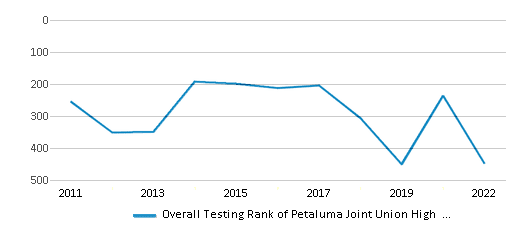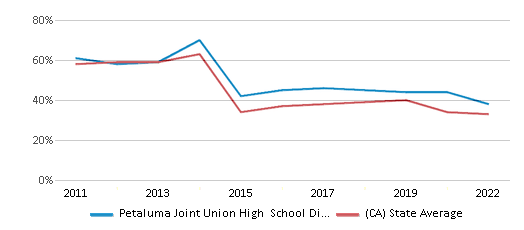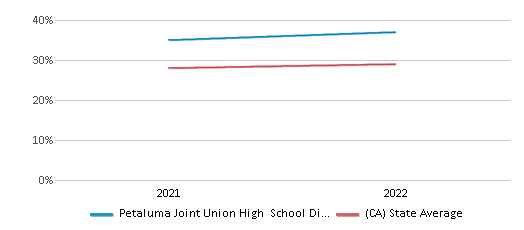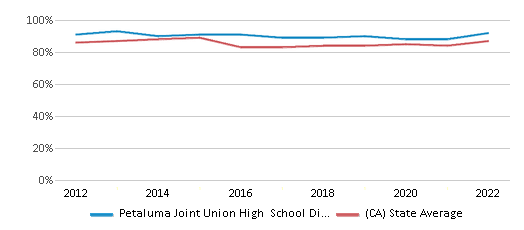Top Rankings
Petaluma Joint Union High School District ranks among the top 20% of public school district in California for:
Category
Attribute
Community Size
Largest student body (number of students) (Top 1%)
For the 2025 school year, there is 1 public elementary school serving 482 students in Petaluma Joint Union High School District. This district's average elementary testing ranking is 8/10, which is in the top 30% of public elementary schools in California.
Public Elementary School in Petaluma Joint Union High School District have an average math proficiency score of 40% (versus the California public elementary school average of 35%), and reading proficiency score of 57% (versus the 45% statewide average).
Minority enrollment is 26% of the student body (majority Hispanic), which is less than the California public elementary school average of 79% (majority Hispanic).
Overview
This School District
This State (CA)
# Schools
10 Schools
7,700 Schools
# Students
4,902 Students
3,822,920 Students
# Teachers
234 Teachers
174,000 Teachers
Student : Teacher Ratio
21:1
21:1
District Rank
Petaluma Joint Union High School District, which is ranked #465 of all 1,925 school districts in California (based off of combined math and reading proficiency testing data) for the 2021-2022 school year.
The school district's graduation rate of 92% has increased from 89% over five school years.
Overall District Rank
#448 out of 1941 school districts
(Top 30%)
(Top 30%)

Math Test Scores (% Proficient)
38%
33%

Reading/Language Arts Test Scores (% Proficient)
58%
47%

Science Test Scores (% Proficient)
37%
29%

Graduation Rate
92%
87%

Students by Ethnicity:
Diversity Score
0.60
0.64
# American Indian Students
31 Students
16,785 Students
% American Indian Students
1%
1%
# Asian Students
143 Students
454,357 Students
% Asian Students
3%
12%
# Hispanic Students
1,797 Students
2,114,366 Students
% Hispanic Students
37%
55%
# Black Students
58 Students
189,461 Students
% Black Students
1%
5%
# White Students
2,540 Students
787,389 Students
% White Students
52%
21%
# Hawaiian Students
13 Students
15,077 Students
% Hawaiian Students
n/a
n/a
# Two or more races Students
292 Students
240,557 Students
% of Two or more races Students
6%
6%
Students by Grade:
# Students in PK Grade:
-
83
# Students in K Grade:
68
519,574
# Students in 1st Grade:
46
396,601
# Students in 2nd Grade:
54
414,466
# Students in 3rd Grade:
46
416,628
# Students in 4th Grade:
65
426,360
# Students in 5th Grade:
61
430,582
# Students in 6th Grade:
46
432,936
# Students in 7th Grade:
742
312,207
# Students in 8th Grade:
725
312,649
# Students in 9th Grade:
716
44,929
# Students in 10th Grade:
736
37,487
# Students in 11th Grade:
741
37,249
# Students in 12th Grade:
856
41,169
# Ungraded Students:
-
-
Best Petaluma Joint Union High School District Public Elementary Schools (2025)
School
(Math and Reading Proficiency)
(Math and Reading Proficiency)
Location
Grades
Students
Rank: #11.
Mary Collins Charter School At Cherry Valley
Charter School
(Math: 40% | Reading: 57%)
Rank:
Rank:
8/
Top 30%10
1001 Cherry St.
Petaluma, CA 94952
(707) 778-4740
Petaluma, CA 94952
(707) 778-4740
Grades: K-8
| 482 students
Recent Articles

What Is A Charter School?
Explore the world of charter schools in this comprehensive guide. Learn about their history, how they operate, and the pros and cons of this educational innovation. Discover key facts about charter schools, including admission policies, demographics, and funding, as well as what to look for when considering a charter school for your child.

10 Reasons Why High School Sports Benefit Students
Discover the 10 compelling reasons why high school sports are beneficial for students. This comprehensive article explores how athletics enhance academic performance, foster personal growth, and develop crucial life skills. From improved fitness and time management to leadership development and community representation, learn why participating in high school sports can be a game-changer for students' overall success and well-being.

February 05, 2025
Understanding the U.S. Department of Education: Structure, Impact, and EvolutionWe explore how the Department of Education shapes American education, from its cabinet-level leadership to its impact on millions of students, written for general audiences seeking clarity on this vital institution.





